
IT’S ALL ABOUT PERSPECTIVE
It’s always a privilege to appear as a guest blogger on Scott’s Photoshop Insider Blog. Having a chance to share some of my experiences in photography with Scott’s blog readers is always a pleasure. If anything I say plants a seed in your mind that you then nurture and turn into a unique memorialization of a moment in time, I couldn’t hope for more.
This will be my fourth appearance as Scott’s guest blogger and this time I’ll be chatting about one way to create some sports images that are different than the usual stuff you may see. If you’ve tried your hand at sports photography you know how much competition there is in the field. With camera equipment becoming relatively affordable and with technology advancing so much that pro level equipment is readily available to all, there has been a proliferation of folks who are geared up to shoot sports. With so many new shooters, I find it necessary to do anything I can to distinguish myself from others for the sake of continued photo assignments. Thus, I strive to capture images that stand out from what others capture.
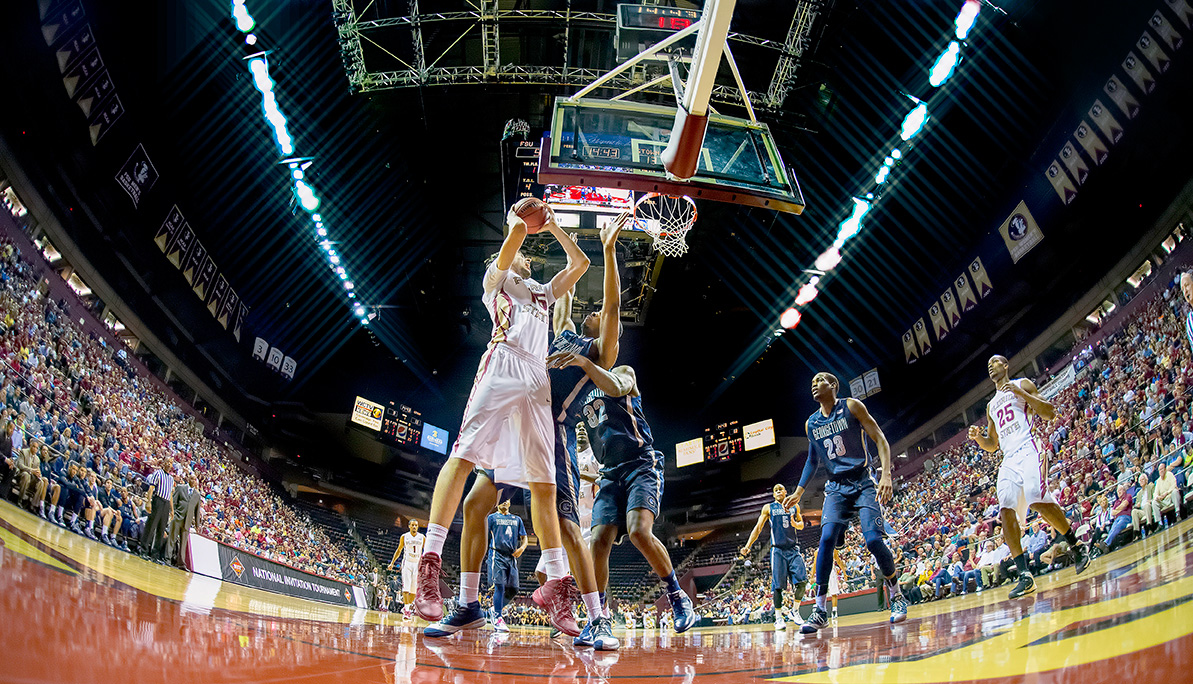
15mm fisheye shot from the floor
For many years, I have used a diagonal fisheye lens to add one or two images to my typical set. The unique image curvature created by this lens is always good for images that are different from typical sports images. The shot above is an example of a basketball image taken with a 15mm fisheye and the camera body placed on the floor angled upward. The problem is that a little fisheye goes a long way. One or two images in a set are plenty.
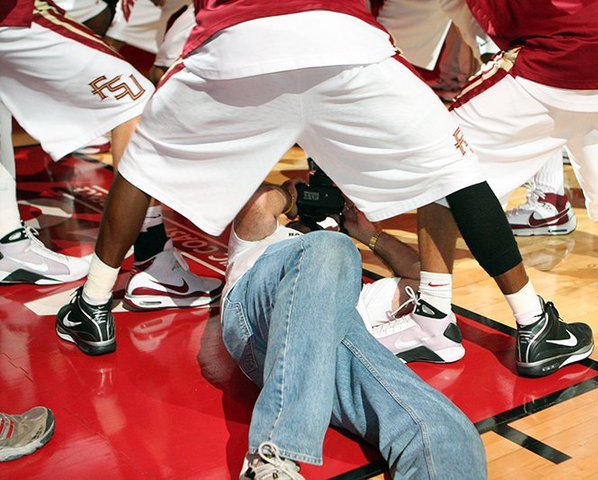
Trying a different perspective for this shot
To supplement equipment in my bag of tricks I try to use creativity as a means of generating novel images. Over time, I have developed a reputation among colleagues as the guy who will try almost anything in order to get a different perspective for an image. It’s become a running joke with my friends and it’s gotten to the point where they are no longer surprised when they find out from where I managed to get a given shot.
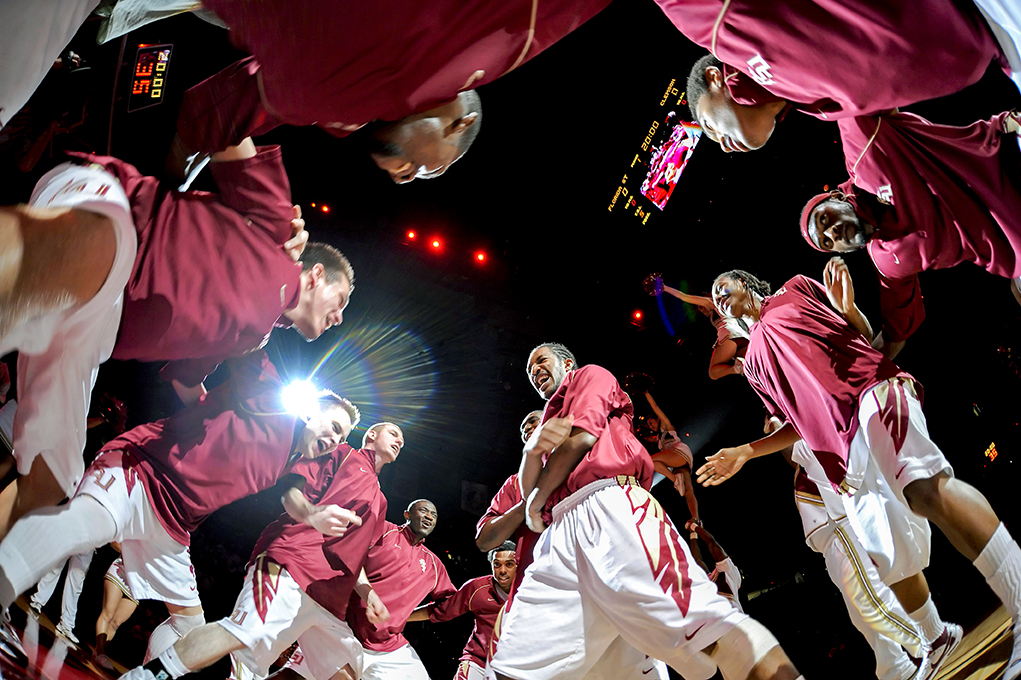
And here’s the shot
My philosophy is pretty simple – the best way to separate my work from that of others is to be creative enough, and sometimes crazy enough, to find unique perspectives for images. The early bird may get the worm, but the creative one is more likely to get the shot that turns heads.
Perspective is one of the easiest things you can change to make an image look completely different from another one depicting the same scene. That’s why for sports like basketball which are played indoors, I have been venturing up into the nosebleed section of FSU’s basketball arena to shoot some images during a game. To do so, I had to force myself to overcome a fear of heights but it has been well worth it for the sake of unique images.
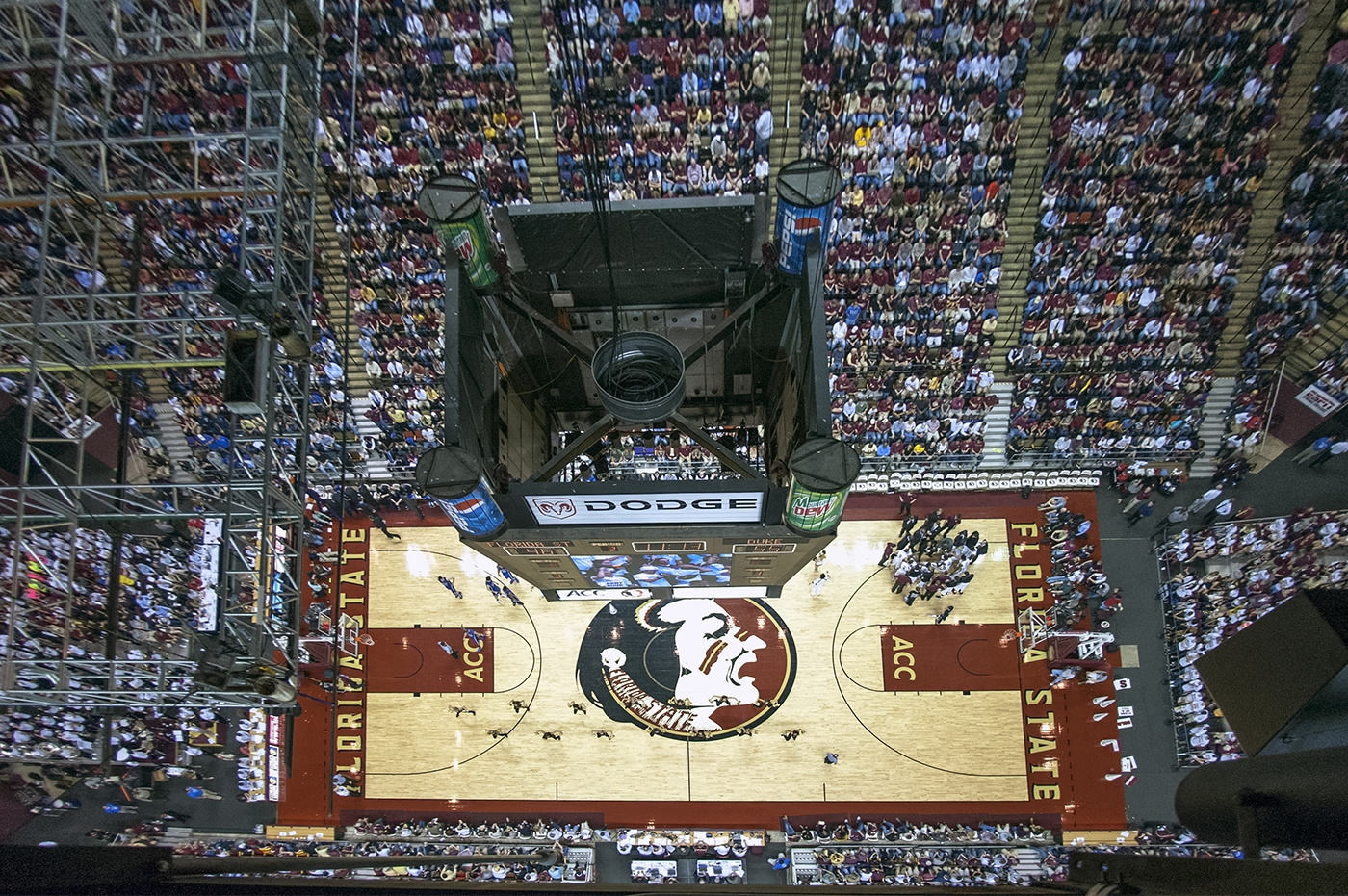
The view of the Tucker Center’s basketball court in Tallahassee, Florida from the catwalks above the arena
Normally, when people talk about going to the nosebleed section of a stadium or an arena it’s usually a sarcastic reference to being relegated to crappy seats. When I tell people that I’m headed to the nosebleed section, it’s not with sarcasm in my voice, it’s with a mixture of excitement, fear, and a lot of trepidation. My version of being in the nosebleed section of an arena is different than sitting in the cheap seats – it’s making my way up to the catwalks that ring FSU’s arena high above the facility.
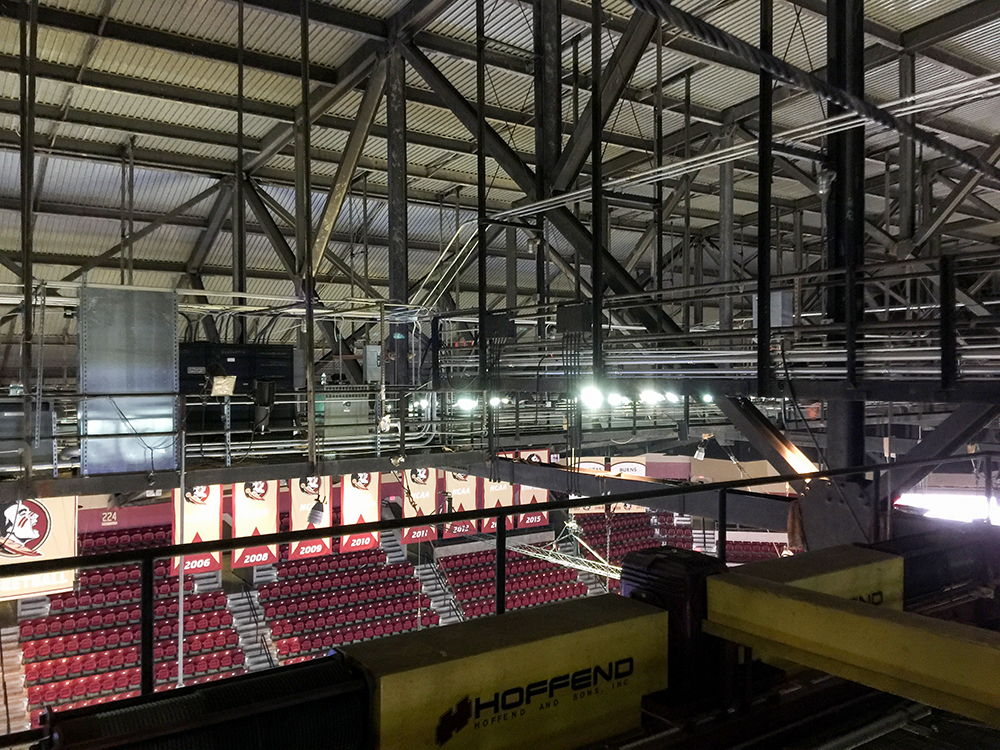
The catwalks and the steel girders that support the structure
In order to get to the best spots from which to shoot, I have to climb up and down ramps, scale ladders, and negotiate obstacles, cables, and lights, all the while petrified beyond words. I don’t like heights. No, that’s an understatement. I really, really hate heights. But when I sit at my computer after a game and look through the images that I get from the catwalks, I can only smile.
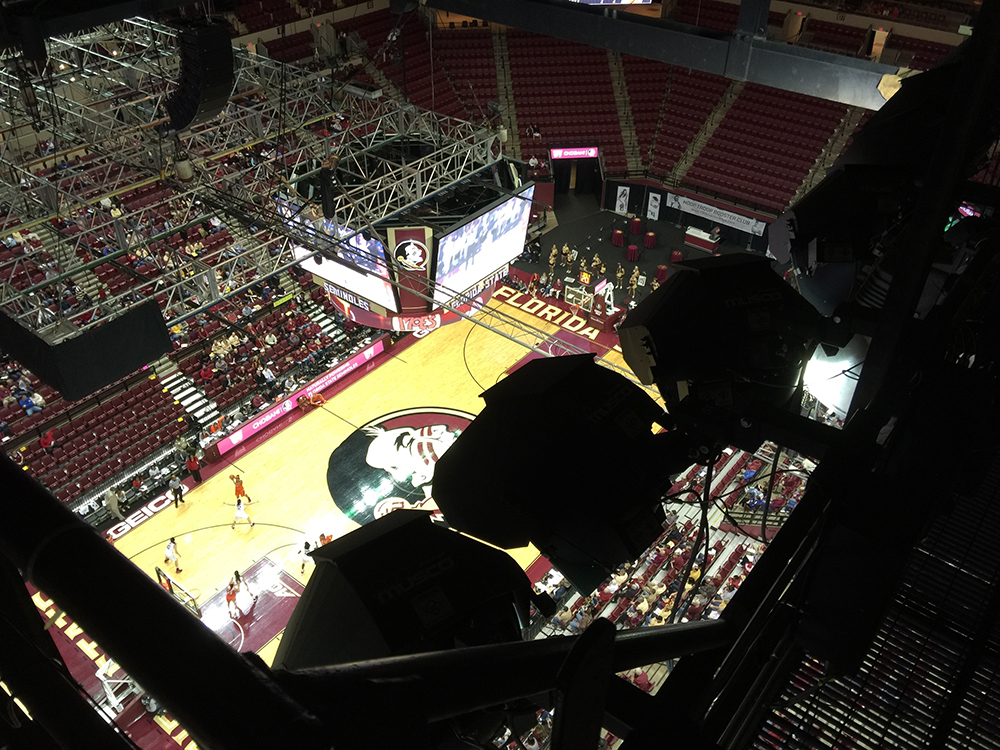
The arena lights just in front of the steel grates that make up the floor of the catwalks
Some photographers set up remote cameras on the catwalks and then trigger them from the floor. For them, spending one minute more than necessary perched on a catwalk sends shivers down their spines. I wish I was more willing to trust technology but I still believe that if I want something done right I need to do it myself. I refuse to trust a camera’s autofocus capabilities or pre-focus on a spot and set the camera to Manual Focus to generate images. I’d rather not hope and pray that a given shot sequence is in focus only to find out later that the images aren’t sharp. Old school still rules so I shoot from above.
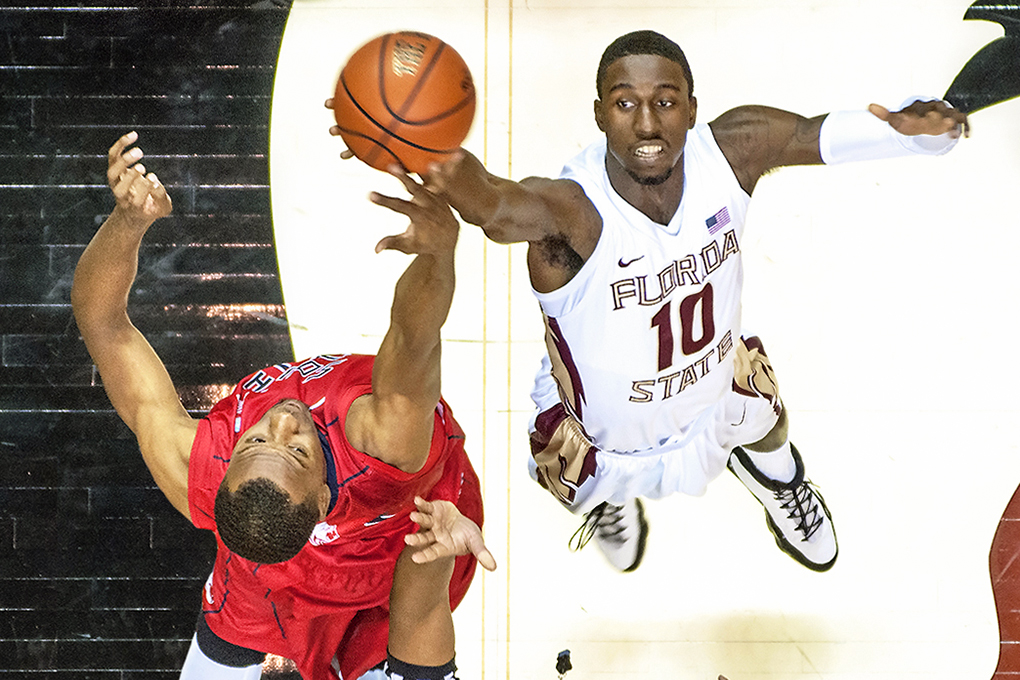

Two shots taken from a side angle
There are some guidelines I follow when venturing up to the catwalks. As far as equipment, I only take one camera body strapped diagonally and securely around my body with the lens attached. Since basketball is the sport I typically photograph from catwalks, I’ll walk you through what I do to shoot basketball from the heavens but the same basic principles apply to anything else that you might shoot from up there.
My lens of choice for basketball is usually a 300mm f2.8 that I hand hold. On occasion I will also take a wide angle lens or my 15mm fisheye for artsy fartsy stuff, but if I take an extra lens it is stuffed deep into my pants pocket. I leave everything else on the arena floor and that includes camera bag, lens hoods, cell phone, monopod, keys, glasses, and anything else that I might accidentally drop from above. Not only are these items superfluous, they pose a risk of serious injury (and possibly even death) to the people below if accidentally dropped.

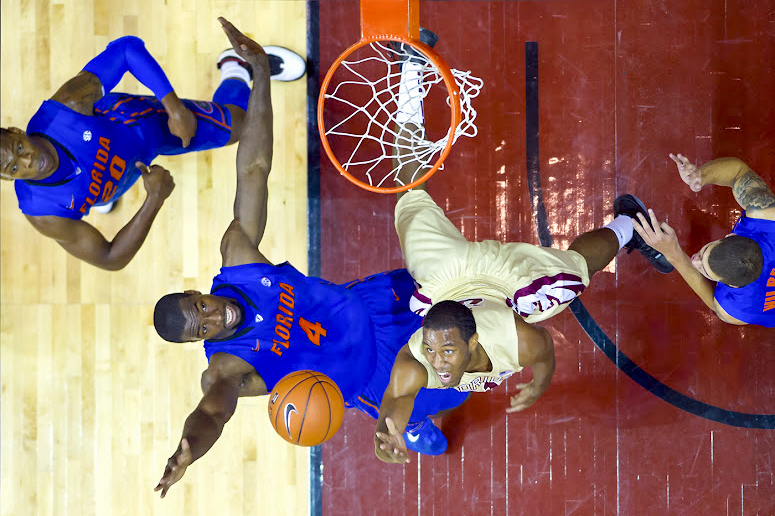
Two more shots taken from a side angle
Some arenas do not have catwalks that run directly above either basket or directly above center court. For a long time, that was the case at FSU’s Tucker Center but I was nevertheless able to find spots where I could position myself to nab some cool stuff. Even though I wasn’t directly over a basket, I was able to alter the images’ perspective somewhat in Photoshop to make them look almost as if they were taken from directly overhead. The two images above are examples of images I shot from the side and then corrected to some extent in Photoshop.
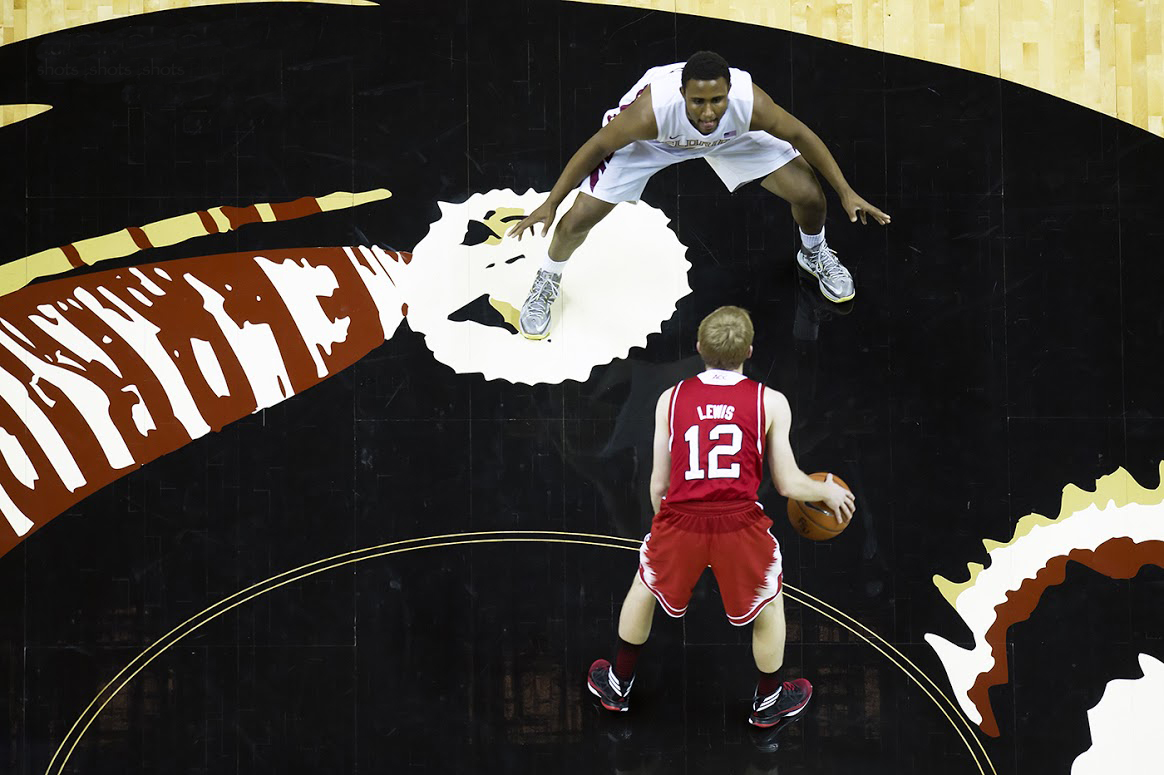
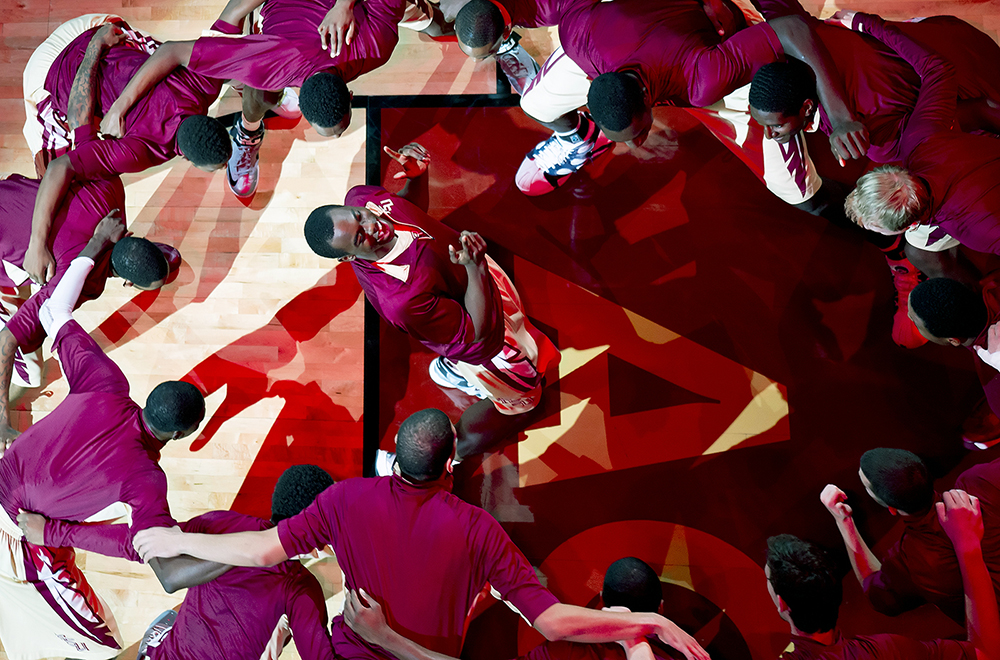
A couple of other images shot from different vantage points
By moving around on the catwalks and changing locations I use different vantage points to get different perspectives on images. I shoot some images vertically but most of the time I stick with a horizontal orientation.
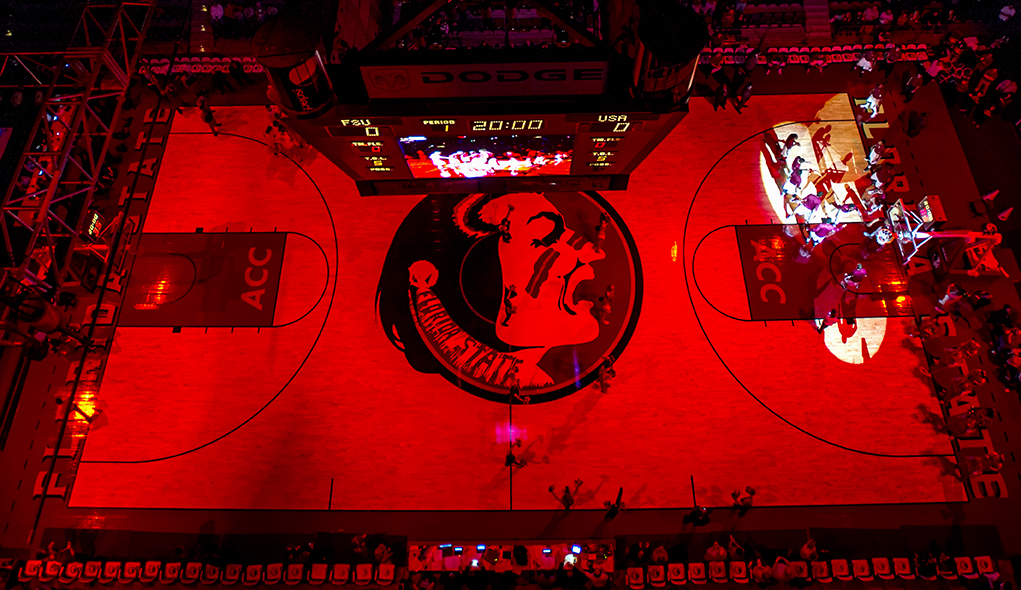
The Tucker Center during player introductions taken with a 17-35mm lens
I use a wide lens for shots of the venue during games that pit FSU against teams that are usually highly ranked, such as Duke, Louisville, or North Carolina. These games usually mean that the seats in the arena will be full which lends itself to desirable images. But after those shots are in the can I switch to the 300mm lens. The 300mm on a full frame camera body is ideal from up top because it lets me get tight on the action while still allowing me to follow it so I don’t miss too many shots.

The grate over the center catwalk supported by girders underneath. Top/center is the opening through which I shoot
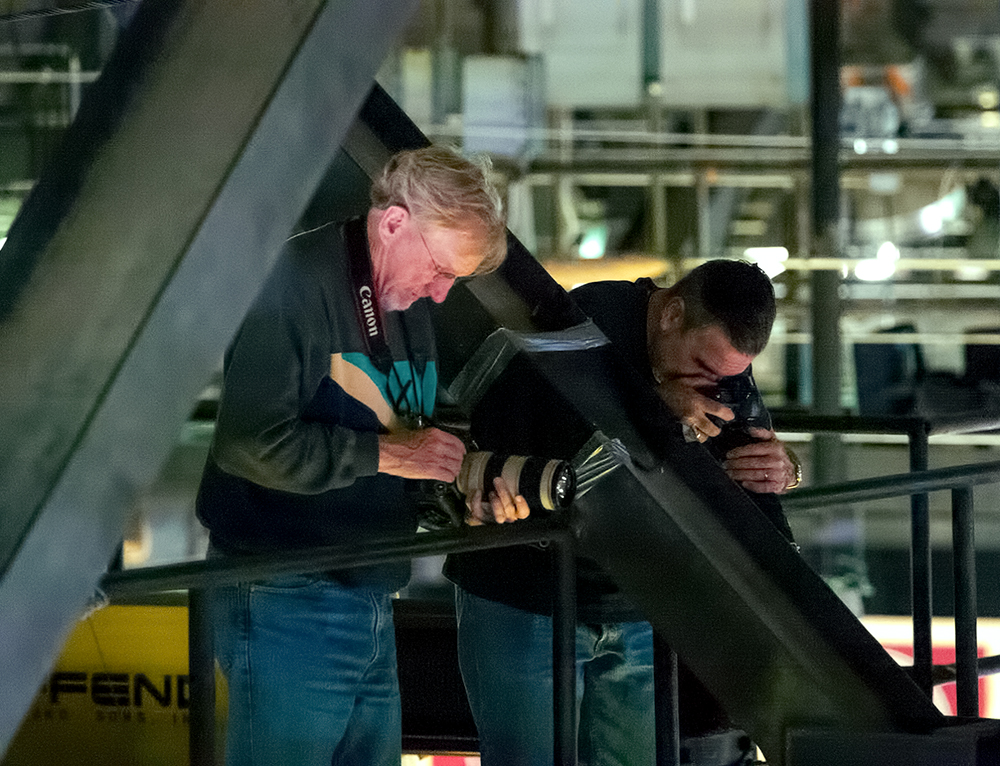
Me (right) and a colleague (left) shooting from the catwalk pictured above. Photo by Colin Abbey
The best shots from overhead are when players are looking up at the rim or up at the ball, such as the opening tip, going for a rebound, about to release a floater in the lane, or just before a dunk. Last year, Florida State renovated the Tucker Center and finally cleared out an area that has a small opening over each of the baskets so I can now shoot from a position almost directly overhead. That is the ideal situation as I can now mix up my shots, some from the sides and some taken from directly overhead.
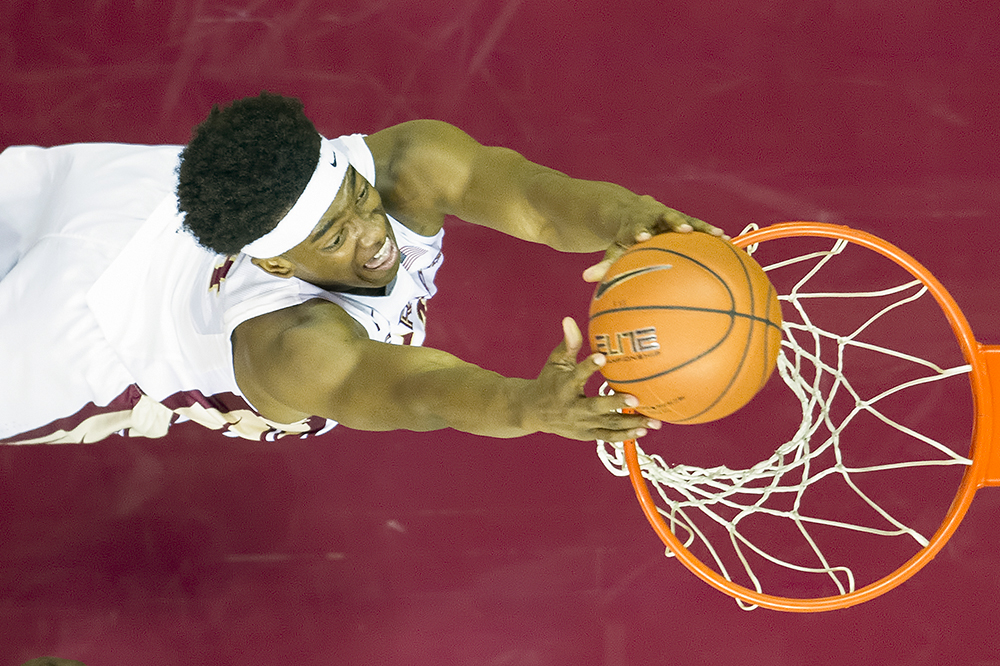
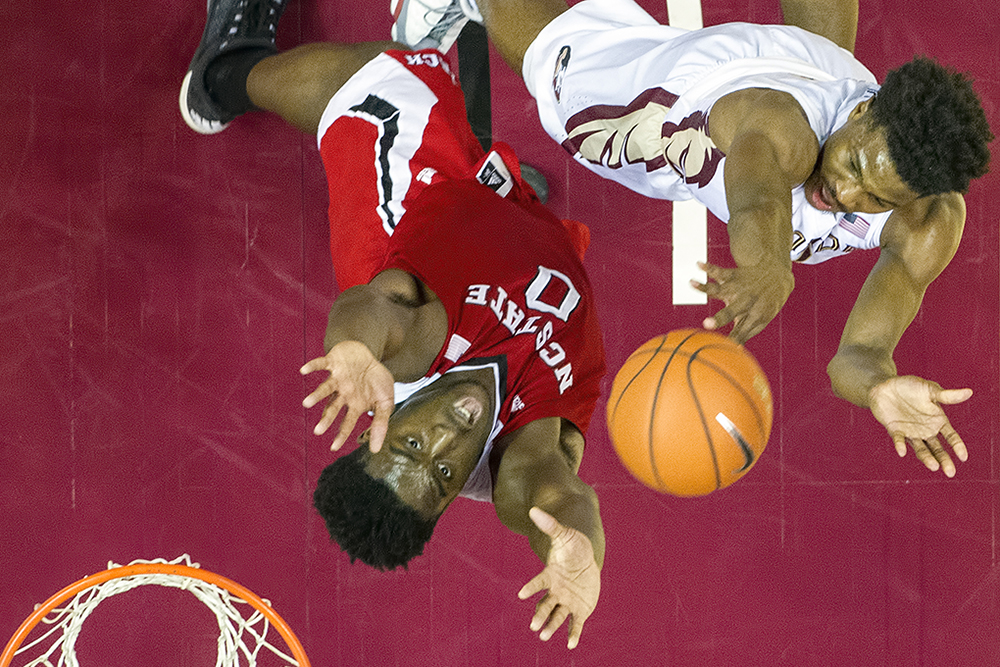
Two images shot from almost directly overhead of the baskets
I try to stay alert even when play stops as opportunities for images often present themselves after the whistle blows. If I had let my guard down after the whistle blew (first image) or after a timeout was called (second image), I would have missed the images below, one of a player who collapsed in pain and the other of a dance team member doing a back flip. Fortunately, I kept an eye on the floor after play was stopped and snapped away.
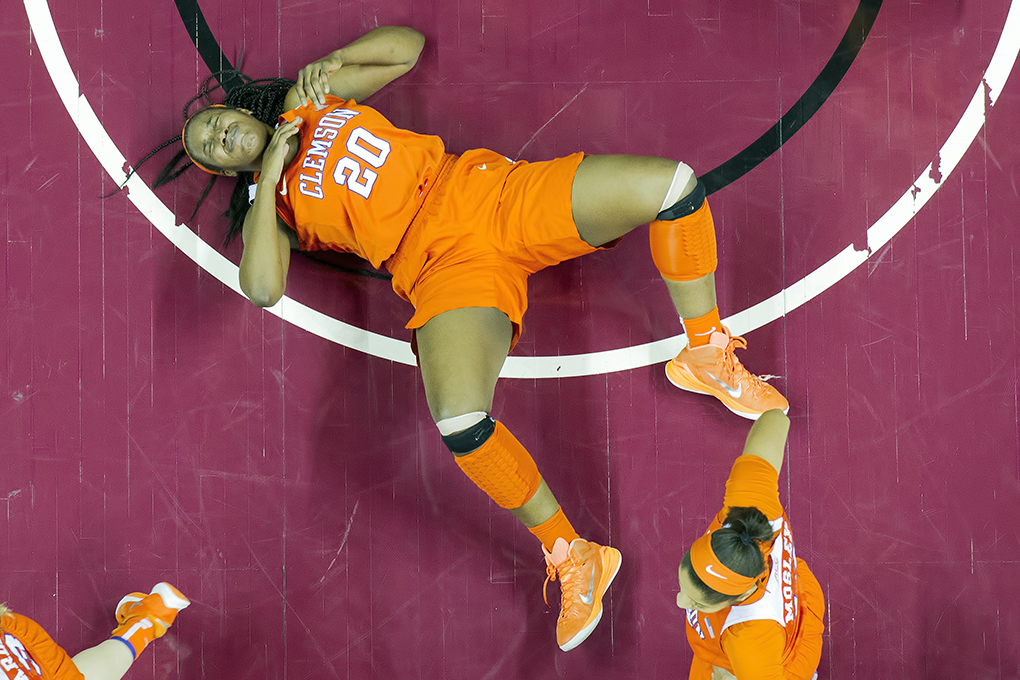
A Clemson player collapses in pain shortly after the whistle blew
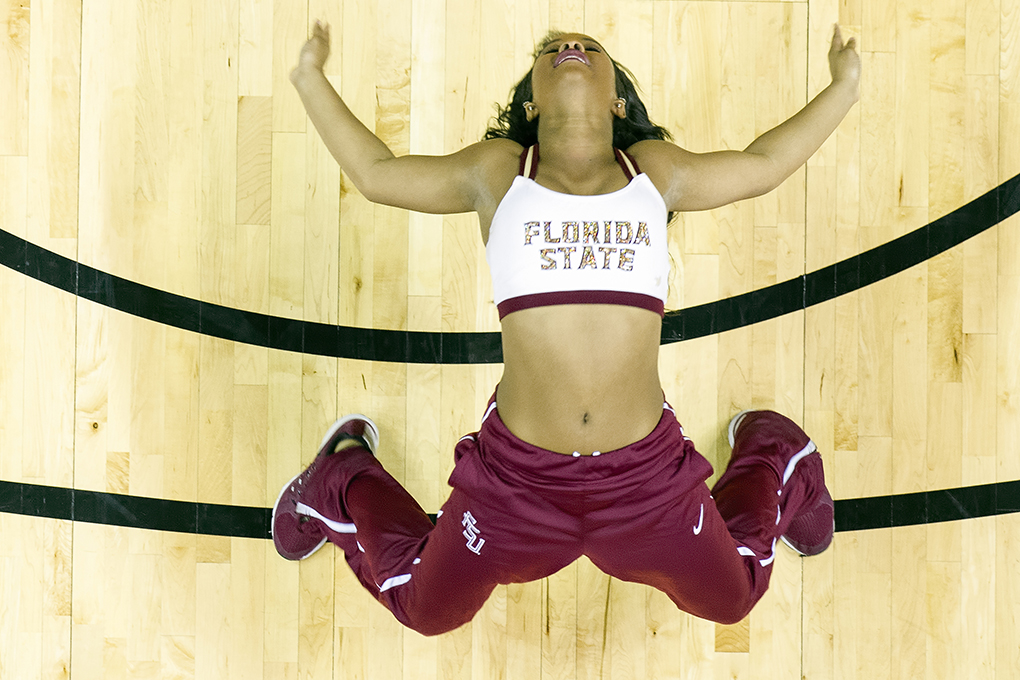
An FSU dancer does a back flip during a time out
Another shooting opportunity presents itself during timeouts. I keep an eye on the game clock and anticipate the media time outs. When I know one is approaching, I’ll boogie over to a spot directly above one of the teams and wait for the players and coaches to gather for their strategy session. Shooting the teams from the catwalks during a timeout yields images that are not your traditional, vanilla time out images. Here are a couple of examples.
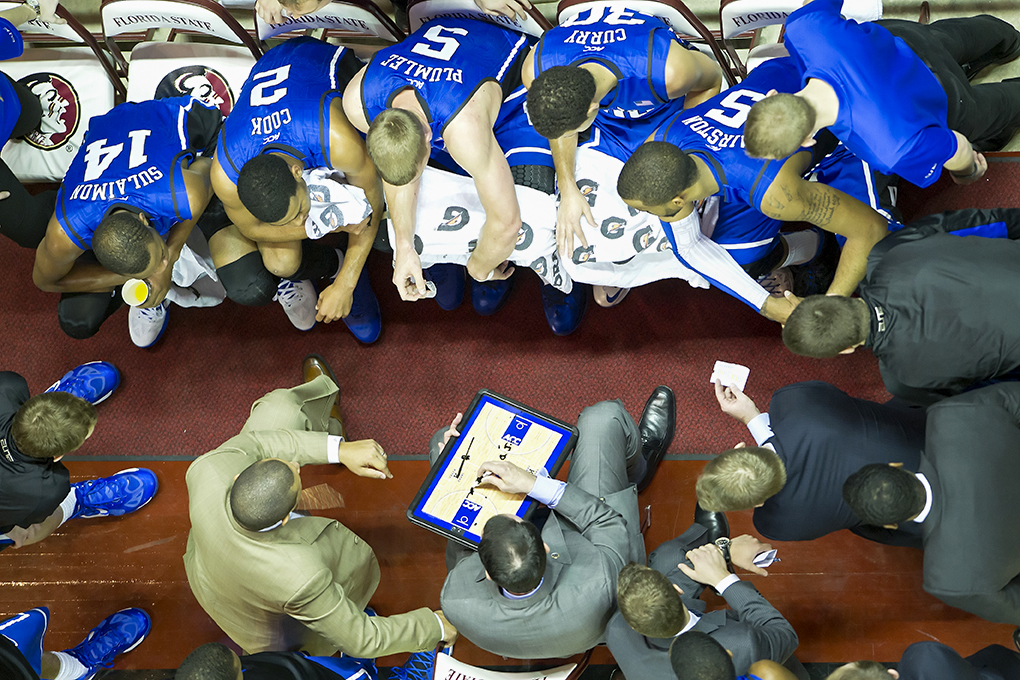
Duke men’s team uses its bench for seating during timeouts
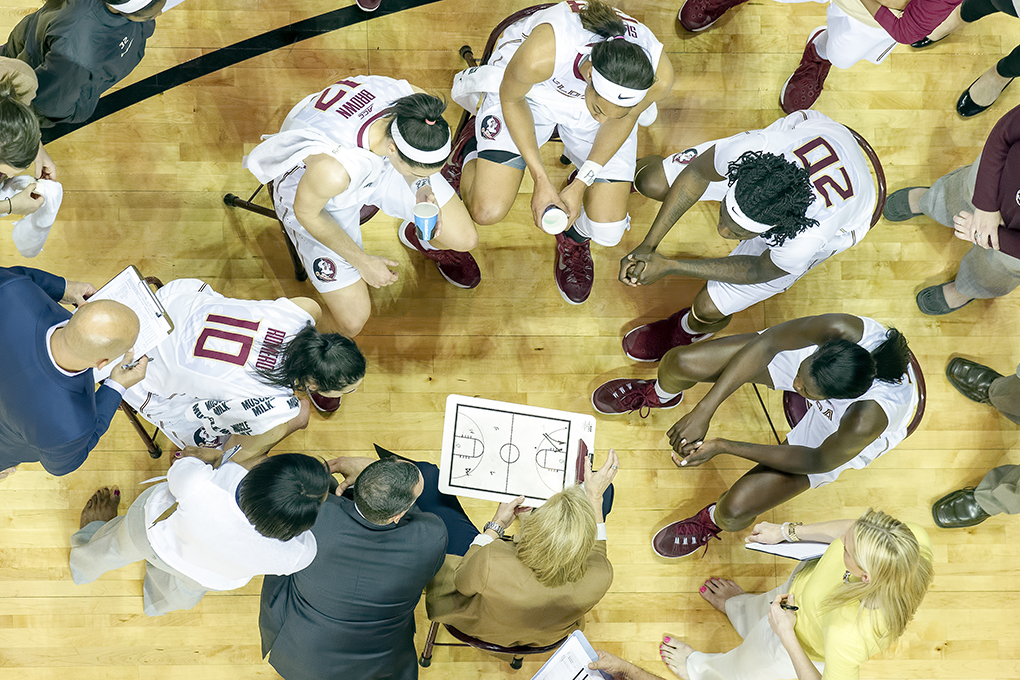
FSU women’s team uses seats brought out to the floor during timeouts
If you’re fortunate enough to have catwalks available for use in your arena, by all means give it a go. To shoot from the catwalks I obtain permission from the arena facilities director to access the catwalks. That individual is usually making the rounds around the floor of the arena before the game. Once I find him and obtain permission, I make sure he contacts his staff via radio to ensure that someone will unlock the stairwell door that leads the catwalks. I make my way to this door long before I intend to shoot so I can slowly, carefully wind my way up and down the ramps and stairs that eventually end up on the catwalk that rings the arena.
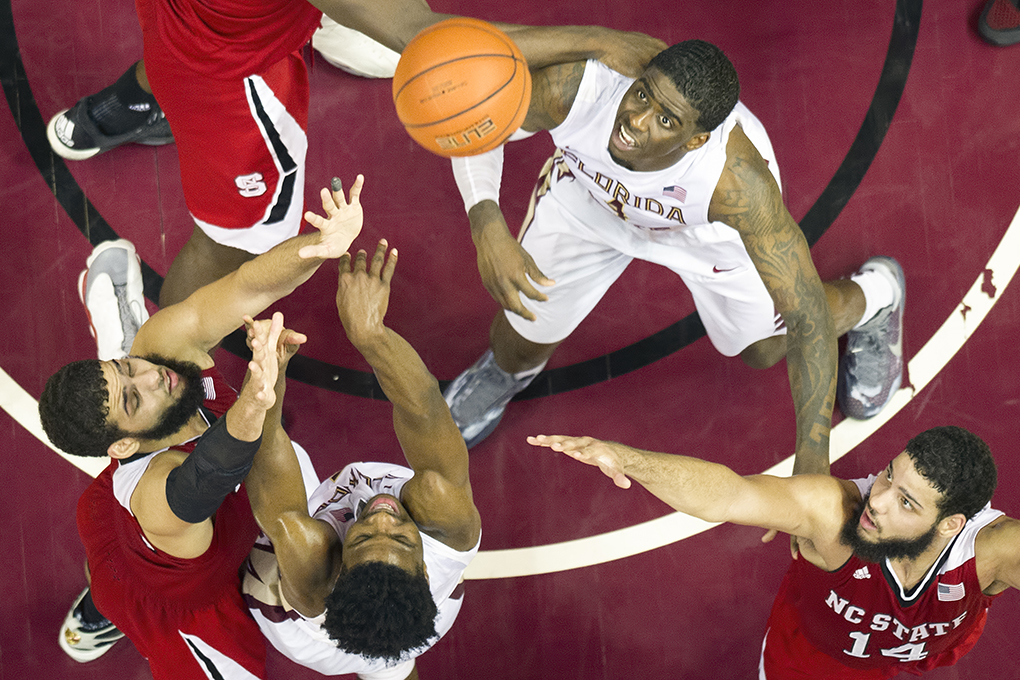
My first time up in the catwalks I made sure to leave myself enough time to get a feel for what it was like up there and explored the vantage points that exist by walking around. I took test shots of the teams as they warmed up to dial in the right exposure and explored the image possibilities from the different vantage points. After that I was all set to create my images.
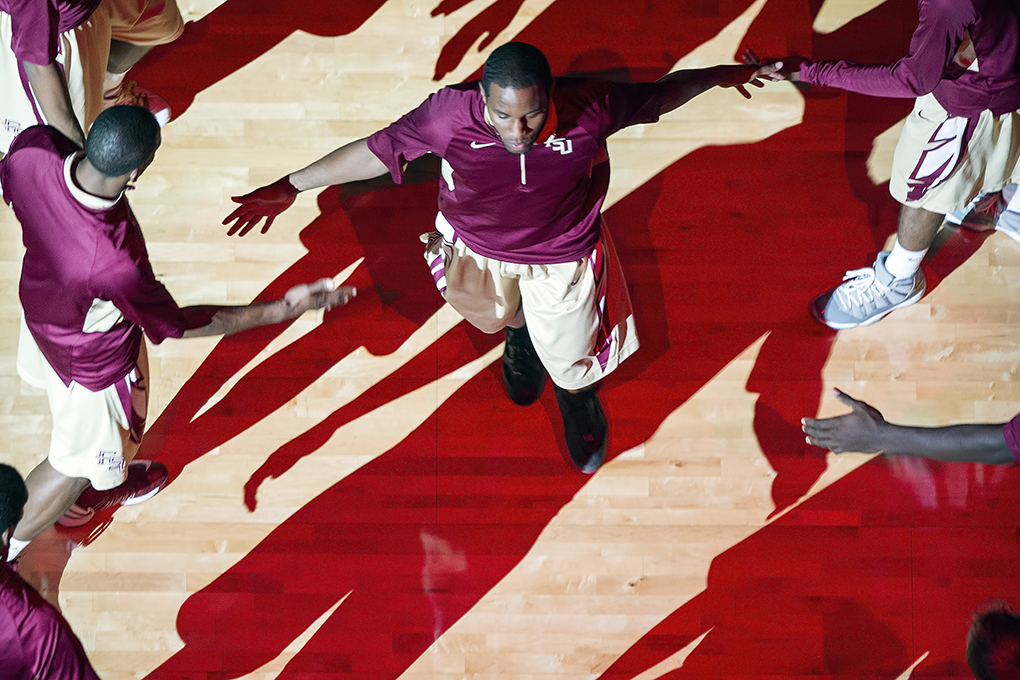
If you make it up to the catwalks of an arena and you’re like me, your heart will be in your throat until you are safely back down on the court. But when you download your cards and take a peek at what you got, you’ll be glad you made it up to the nosebleed section of nosebleed sections.
Miguel (Mike) Antonio Olivella, Jr. is a professional photographer based in Tallahassee, Florida. Mike has been a Featured Photographer for Florida State University Athletics for over ten years and a stringer for two international wire services. Mike’s sports photographs are routinely published worldwide and his astrophotography, wildlife, travel, and landscape images have been exhibited in solo and joint gallery exhibitions. You can see more of Mike’s work at BaselineShots.com, on Google+ , or on Facebook.



That was a great post – text and photos !
Thanks for taking the time to do it !